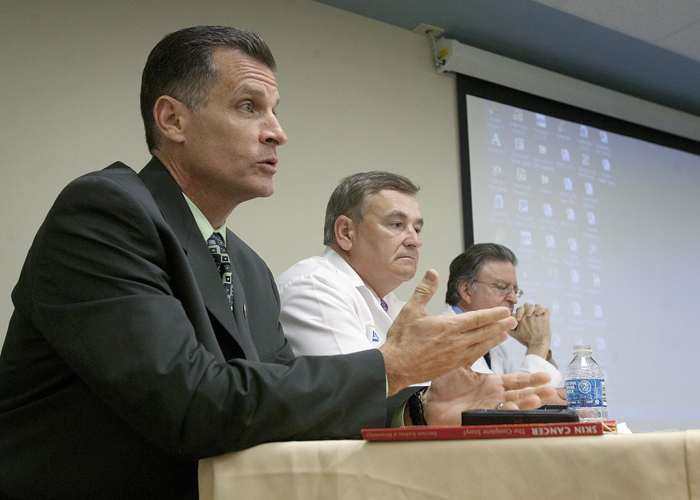
INDIAN RIVER COUNTY — The illustration on the flyer advertising the seminar on “Seeing Spots? Recognizing Skins Cancers” was appropriate: An Audrey Hepburn-type woman with a beehive hairdo wearing a white scarf and a polka dot sundress.
The sundress was fitting because the seminar at the Indian River Medical Center was part of the hospital’s 2013 series of community cancer programs.
The latest one drew a mixed-age audience of about 60 people who learned about the dangerous of over exposure to the sun and its sometime gruesome results.
Skin cancer is a serious issue – particularly in a sunny place like Indian River County where people are outdoors a lot – and the numbers of people with the disease are increasing dramatically.
The seminar concentrated on the three main types of skin cancer: basal cell carcinoma, squamous cell carcinoma and melanoma.
More than 3.5 million cases of basal and squamous cell skin cancer are diagnosed in this country each year, according to the American Cancer Society.
Melanoma, the most serious type of skin cancer of the big three, will account for more than 76,600 cases in 2013 and is by far the more deadly.
Dr. Patrick Ottuso, a dermatologist, said skin cancer cases are increasing rapidly.
Just in his office, Ottuso said, he sees four or five new cases of skin cancer each week.
“Unfortunately, I see of lot of skin cancer here in Indian River County,“ agreed Dr. Ralph Rosato, a plastic surgeon.
He estimated he treats about 100 cases of melanoma a year and 400 cases of basal and squamous cell carcinomas.
Ottuso said the patient is the first person in the line of skin cancer defense.
He urged members of the audience to examine their own bodies and see a dermatologist at least once a year.
Signs that people could have a problem include a spot being asymmetrical, meaning one side doesn’t match the other unlike a healthy mole.
The borders of melanoma are uneven or ragged and may consist of several colors, unlike non-cancerous spots, according to Ottuso.
Basal cell cancers, Ottuso said, are the easiest to treat.
“They do not usually spread to other parts of the body,” he added. “If caught early, it is easy to treat.”
Ottuso also said about 50 percent of the people who develop a basal cancer spot are likely to develop another one within five years.
One sign of trouble, Ottuso said, is if the pimple doesn’t heal. If that’s the case after about two weeks, he advised patients to get themselves to their dermatologist.
Typically, Ottuso said, both basal cell and squamous carcinomas are generally the result of exposure to the sun. However, he stressed that he has even seen them on the bottom of a patient’s foot and in areas where the “sun doesn’t shine.”
Squamous carcinomas are more dangerous than basal cell and can be fatal if not treated.
Treatments range from freezing and scrapping to cutting and burning, Ottuso said.
Rosato said if surgery is needed for basal cell carcinoma it requires removal of about 3/8’s of an inch of skin around the spot.
That grows when dealing with squamous cancers because the cells might extend deeper into the surrounding area. The size of the surgical cut is about twice the size of that done on basal cell, he said.
In the case of melanoma, the surgery is much more invasive, Rosato said, making a fist and telling the audience the area to be removed would be about the size of that fist.
During his address, Dr. Ira Gleiberman, a pathologist, reviewed the three major forms of skin cancers and how they attack cells, outlining how they can spread and how physicians track that spread.
For example, Gleiberman said doctors dealing with melanomas will generally check nearby lymph nodes to see if the cancer has spread to them.
If it has, the doctor would remove it and possibly other nodes to keep cancer from spreading to other organs.
The bottom line with melanomas at this point in medicine is simple.
“You can’t cure melanoma without surgery,” Rosato said.
He said some new chemotherapies show promise for treatment but surgery still remains the best plan of attack.
Rosato showed a variety of explicit slides that illustrated the surgery needed to remove the skin cancers and his job in stitching the patients up.
He said the images are often gruesome, but stressed many patients appear quite normal after the plastic surgery and the incisions have been given time to heal.
“As a plastic surgeon it is my job to make it look like the cancer was not there,” Rosato said.
People might not be able to avoid skin cancers but they can certainly cut down on their chances of getting the disease.
Ottuso encouraged those in the audience to use sun block and sun screen and put it on a good half-hour before going out in the sun.
“Every two hours, reapply it,” he said.
“Remember, it’s also not sun exposed skin,” said Ottuso, again pushing the need for annual exams.
“It’s said that if you live long enough you’ll get a basal cell,” said Rosato, who pointed out he’s seeing people in their 80s with the disease for the first time.



